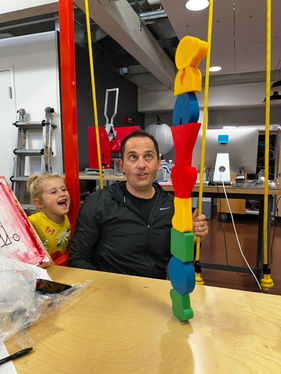
Our shop is currently closed until further notice. If you are interested in purchasing artwork, please email leanna@okhuupolamimi.com or camilla@okhuupolamimi.com
Brainstorm to Product: Mix a Majigs
MEDIA
PROMPT
The Mix-a-Majigs were the product of a 20-week Design Capstone project. We broke into teams of 3-4 people from our cohort based on what design space we were interested in: physical, digital, or experiential. In our case, the four of us wanted to make something physical. Our instructions were to work in a problem space, develop a product, and bring it into the world by the end of 2 quarters.
PROCESS
I was the main driver of our initial ideation space and kicked off our interviews with the directors at Bing Nursery School. I started out by exploring how animal pieces could work together if they were able to interchange pieces. This idea morphed into more abstract shapes as we focused more on open-endedness and imaginative play. We developed our first round of foam prototypes and tested them with 3-5 year olds at Bing. We got lots of positive feedback and they played so much with them, they broke them. There were lots of questions about whether there would be more, or with more colors. We took this feedback, made a second iteration of foam prototypes, and planned on making the final product out of wood until a conversation with a toy designer from Melissa & Doug. He noted that our current design would most likely not pass a drop test, and would be better made from plastic. At this point, we pivoted to 3D printing with PLA.
PRODUCT
We presented our final set of 3D printed pieces at the Tradeshow, the culmination of the Design Capstone. My team was really pleased with how the pieces fit together, that there was something satisfying about it. We had also presented the set to our Coach’s daughter, who approved the Mix-a-Majigs by building as tall a tower as she could, and then building three figures: Mom, Dad, and Me. This project was a success and we thought we delivered on everything we set out to.
PITFALLS
Since this was the longest project in our Stanford design careers, we were able to see parts of a project that there wouldn’t normally be enough time for. In our case, it was a lull in our team’s productivity over the break between quarters in the middle of the project. We struggled to maintain our pace, and our final presentation may have been a bit more polished had we not experienced that setback.
















